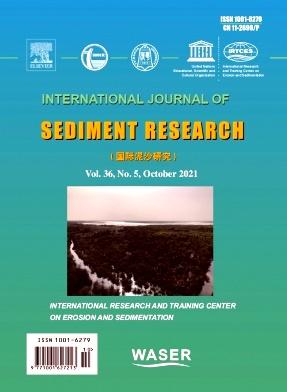Experimental study on the self-cleaning behavior of slit dams for debris flow hazard mitigation
IF 3.5
2区 环境科学与生态学
Q2 ENVIRONMENTAL SCIENCES
引用次数: 0
Abstract
Self-cleaning is a crucial feature of slit dams, which not only enhances upstream and downstream hydraulic connections but also automatically restores a dam's debris flow storage capacity. In this work, a series of specially designed flume tests are performed to simulate the self-cleaning process. The flow rate, relative opening, bed-slope angle, and number of openings are considered. The erosion process, topographic characteristics, and relative erosion depth are analyzed to gain insight into the self-cleaning details. The current results reveal that when the boulders jamming the openings are removed, erosion occurs in three stages (downcutting, headward erosion, and lateral erosion). Conversely, when the blockage remains stable, only surface armoring occurs. Furthermore, after the self-cleaning process reaches a quasiequilibrium state, the topographic features are summarized, and the differences in the maximum erosion depth at the opening are analyzed for different experimental conditions. This paper proposes a critical criterion (F) for the self-cleaning of slit dams on the basis of dimensional analysis. The critical criterion takes into account the interactions of three parameters (Froude number, relative opening, and opening rate) and can be conveniently applied to existing slit dams. When F is less than 0.25, the opening remains blocked, and only surface armoring occurs; when F is between 0.25 and 0.38, the blockage may be removed; and when F is greater than 0.38, self-cleaning leads to massive erosion, and the blockage is removed. Therefore, the proposed critical criterion can help design the opening dimensions of a slit dam, restoring its storage capacity. Finally, the positive effect of self-cleaning on restoring the storage capacity of slit dams is discussed.
裂隙坝泥石流自洁特性试验研究
自清洁是裂隙坝的一个重要特征,它不仅增强了上游和下游的水力连接,而且自动恢复了大坝的泥石流储存能力。在这项工作中,进行了一系列专门设计的水槽试验来模拟自清洁过程。考虑了流量、相对开度、床坡角和开度数。分析了侵蚀过程、地形特征和相对侵蚀深度,以深入了解自清洁的细节。目前的研究结果表明,当堵塞孔洞的巨石被移除时,侵蚀发生三个阶段(向下侵蚀、向内侵蚀和侧向侵蚀)。相反,当堵塞保持稳定时,只发生表面装甲。此外,在自清洁过程达到平衡状态后,总结了地形特征,分析了不同实验条件下洞口最大侵蚀深度的差异。本文在量纲分析的基础上,提出了裂隙坝自洁的临界判据F。该临界准则考虑了三个参数(弗劳德数、相对开度和开度)的相互作用,可以方便地应用于现有的裂隙坝。当F < 0.25时,孔口保持堵塞状态,只发生表面铠装;当F在0.25 ~ 0.38之间时,可以排除堵塞;当F大于0.38时,自清洗导致大量侵蚀,堵塞被清除。因此,所提出的临界准则可以帮助设计裂隙坝的开口尺寸,恢复其库容。最后,讨论了自清洁对裂隙坝库容恢复的积极作用。
本文章由计算机程序翻译,如有差异,请以英文原文为准。
求助全文
约1分钟内获得全文
求助全文
来源期刊
CiteScore
6.90
自引率
5.60%
发文量
88
审稿时长
74 days
期刊介绍:
International Journal of Sediment Research, the Official Journal of The International Research and Training Center on Erosion and Sedimentation and The World Association for Sedimentation and Erosion Research, publishes scientific and technical papers on all aspects of erosion and sedimentation interpreted in its widest sense.
The subject matter is to include not only the mechanics of sediment transport and fluvial processes, but also what is related to geography, geomorphology, soil erosion, watershed management, sedimentology, environmental and ecological impacts of sedimentation, social and economical effects of sedimentation and its assessment, etc. Special attention is paid to engineering problems related to sedimentation and erosion.

 求助内容:
求助内容: 应助结果提醒方式:
应助结果提醒方式:


